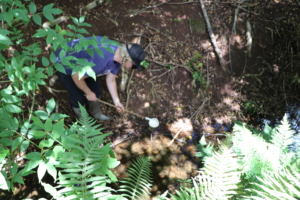Allison Cabrera is the Kaua‘i Forest Bird Recovery Project’s (KFBRP) “Mosquito Trapping Queen”. Cabrera travels from Līhuʻe to Koke‘e almost everyday to check mosquito traps and visit pools of standing water, where she catches the insects and treats water-filled road potholes to kill any mosquito larvae they may harbor.
“My main objective is to monitor the abundance and distribution of the southern house mosquito, which is the species that carries avian malaria,” Cabrera explained. The disease-carrying mosquitoes are responsible for the perilous state of the Hawaiian honeycreeper, the ‘akikiki, of which there are fewer than 40 individuals left in the wild.
According to a recent DLNR press release, KFBRP has been collecting mosquito data for more than ten years, building on a data set previously collected by the U.S. Geological Survey. Dr. Lisa, ‘Cali’ Crampton, the KFBRP Project Leader, said, “Kaua‘i, being a lower elevation island, was thought to be the canary in the coal mine for the advance of avian malaria into forest bird habitat. Other projects on other islands were in areas where native forest birds were thought to be more out of reach of avian malaria, so they started their survey programs later than ours.”
On Kaua‘i, Maui, and Hawai‘i Island, mosquito trapping surveys now have a sense of urgency, with three species of honeycreepers (‘akikiki, ‘akeke‘e, kiwikiu) on the brink of extinction. “Once upon a time you would have found ‘akikiki throughout our forests. When I first joined this project (KFBRP) in 2010 you could frequently see the birds on the famous Alakaʻi Swamp boardwalk, and now they have receded into the deepest, most remote mountainous regions, as a result largely of mosquito-borne disease,” Crampton added.
Mosquito-trapping teams use two types of traps to gather data for potential landscape-scale mosquito management. One is a carbon dioxide trap that attracts blood-seeking female mosquitos, and the other is called a gravid trap, which uses a stinky water solution to trap mosquitoes ready to lay eggs. On Kaua‘i, the KFBRP team runs eight of each trap type at three different locations. Once a female southern house mosquito is trapped by either trap type, they are put into small test tubes and the samples are sent to labs where they are tested for avian malaria.
Crampton noted, “When we first started this there was not much avian malaria up on the Alakaʻi Plateau…zero out of ten, or maybe one out of ten mosquitoes tested positive. Now, we see as many as four out of ten testing for avian malaria now that the disease dynamics have started to ramp up on the plateau.”
In a recent blog post, we detailed the rescue of a single ‘akikiki in an area that used to have an abundance of the birds. It’s believed the bird, named Carrot, is one of two remaining in an area that as few as seven years ago supported more than 70 ʻakikiki.
Mosquito trapping this year will help the group of government and non-governmental organizations known as the “Birds, Not Mosquitoes collaborative”, decide how and where to distribute incompatible male mosquitoes into forest habitats that are most severely impacted by avian malaria. Male mosquitos are used in this technique because they do not bite or transmit disease and when incompatible males breed with wild female mosquitoes, no viable eggs are produced. It’s like “mosquito birth control”, which then causes mosquito populations to decline.
Later this year, draft environmental assessments (EAs) on mosquito suppression projects on Kaua‘i and Maui are expected to be released, for public comment.
Cabrera reflected, “I feel proud and honored to do this work in such a special place. It means the world to me. I take this job very seriously, as I feel we are doing really important work and hopefully helping to save these forest birds.”
Allie and the project have recently been featured in the Garden Island News, explaining the project.
On September 7th, 2022, the Kauaʻi County Council passed a resolution urging elected officials throughout the state to fund and implement mosquito birth control for the purpose of preventing the extinction of these birds. You can read more about this at Kauaʻi Now News. This is good news for kauaʻi’s birds.
You can learn more about KFBRP’s mosquito trapping surveys and testing for avian malaria in the DLNR videos below.



